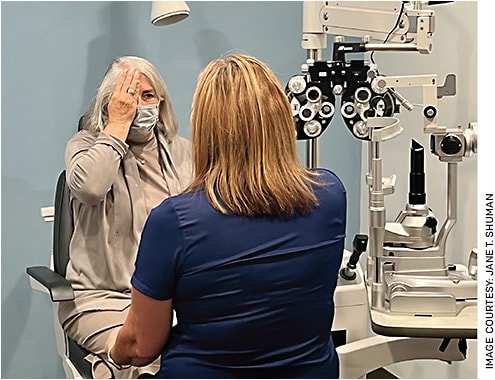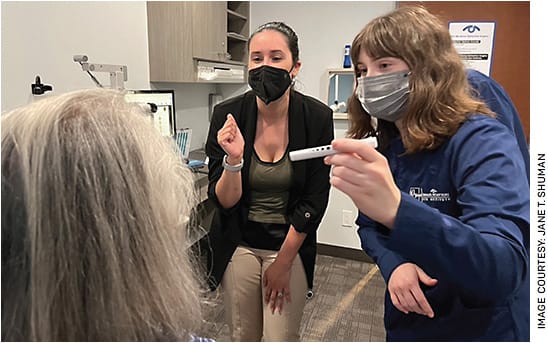As I write this, the coronavirus is making news again. The newest strain(s) of the virus is not nearly as devastating as the earliest ones, but the number of cases and hospitalizations is rising. And, aside from coronavirus, we’re now in regular old cold and flu season.
For workplaces, these realities likely mean that the frequency of call-outs will increase — a burden to our current staff who will have to work harder in a job they feel is already stressful.
All departments of a practice feel the effect of sick calls. As a result of the pandemic, many offices instituted remote positions that allow people under quarantine to continue working. Others utilized software programs to increase efficiencies while limiting physical contact. But these developments will not help the technicians, whose job requires them to be in the room with the patient.
So, how to “sick proof” your practice? It starts with hiring quality staff and providing adequate training.
HIRING NEW STAFF
Don’t wait for another crisis
It is said that the best defense is a good offense. In this case, that means plan ahead. Keeping our own immune systems strong is one way to ward off the bugs our kids bring home from school. We all know a healthy diet and exercise are the keys to good health. I know of a practice that has had a local branch of Weight Watchers hold a weekly onsite lunch meeting for employees willing to join. Another group created a walking club, at lunch or after work. After all, misery loves company!
If you are fortunate enough to be fully staffed, can you afford to hire for positions in departments that run behind? For instance, if claims are sent late and denials not worked, the improvement in cash flow should justify another employee. Another possible opportunity is to hire someone to float between areas to pick up the slack when needed. This may be the call center and reception, scribes and billing or even reception and visual fields.
The most egregious mistake you can make is to settle for just a “warm body” or someone who does not fit the practice culture. Trust your gut — and references. When calling former employers, the most relevant question is, “Is this person eligible for rehire?”
Start with what you have
The first place to look for candidates is within your current staff. Many people who are excellent at their jobs are fearful of challenging themselves with new tasks and hesitate to ask for more. They think, “What if I don’t perform as well; will I be fired?”
For those who you think are capable of doing more but might be hesitant, begin by delegating additional work to them and see how they respond. This may open the door for a conversation about their career goals and ultimately someone to fill a void.
Consider these hunting grounds
You may be running ads and have a career page on the practice website, but have you considered internal marketing? Your patients may have an adult child or grandchild who is looking for work. If not, word of mouth in their social circles may be successful. Techs are often asked if they have gone to school for this work; this is the opening to discuss on-the-job training and perhaps the patient knows someone that would like this specialized area of health care.
When you engage with someone in another service industry who does their job well, ask if they have considered another career and hand them your business card. The best places to find them are in a retail or restaurant setting. Great selling points for many are that nights and weekends are not required and that they are paid while training. And that they would be embarking on a career.
THE TECH CRISIS
It’s bigger than ophthalmology
Ophthalmology is still dealing with a scarcity of technicians. Finding them seems to be the bane of practices throughout the country. Before we address the technician issue, though, it’s important to recognize that the shortage of health-care workers is an issue throughout our health-care system. The pandemic resulted in the retirement of older workers; employees with young families and older parents found they could remain home, take care of family and do with less. And according to Forbes,1 many younger workers have rejected a career in health care as a result of the pandemic.

‘The education marketplace has shifted’
Many high school graduates have opted not to go to college immediately after graduation, according to the National Student Clearinghouse Research Center’s 2021 report.2 Cost is a frequent factor, especially for high school grads who don’t know what they want to do after college.
But there are other reasons as well. A study by the Gates Foundation notes that the “education marketplace has shifted.” Almost 50% of the people surveyed indicated they have learned skills or were exposed to career options watching YouTube videos or received a certificate from online courses.3 Additionally, a very high value was placed on on-the-job training as demonstrated by the 70% of respondents (a total of 1,675) that agreed with the statement “On-the-job training is the best path to career advancement.”3
So, we can conclude that the opportunity to earn while training will likely appeal to these students. Practices should try to use this to our advantage.
How to partner with schools
One way to get the attention of high school juniors and seniors is to partner with the schools in your area. Some metropolitan areas have schools that are specific for health and sciences. For example, the Montgomery County (Md.) School System offers the Academy of Health Professions. Although ophthalmic assisting is not listed, medical assisting is one of the offerings. If internships are part of the curriculum, you can offer to participate.
Suggest that the placement counselor observe what is required of ophthalmic techs. Hopefully, they will place someone at the top of the class who is driven to succeed.
Prior to making an offer to a prospective intern, have the candidate observe their future position for a few hours. Ideally, this should be one of the busier sessions during the week, so they can get a realistic picture of patient flow in their respective areas. Introduce them to several members of that department and solicit your staff members’ opinions of them. The candidates will share information with them that are not likely to be brought up to a future supervisor.
TRAINING THAT NEW HIRE
Never assume
That brings us to training the new employees once you have hired them. No matter how desperate you are to get people into their proper positions, do not assume they know how to do their job. There must be an onboarding process for all new employees; much of the set up can be done before the actual start date, such as logins, uniforms, paperwork packet, etc.
When the new hire is situated in their department, assign them a “buddy” to train them. Each department should have an organized training program. This can be a manual with screenshots of computer entry, a walk-through of the various processes or online videos.
In each case, when it’s time for the new hire to stop observing and start doing, the buddy should be by their side to answer questions and provide feedback.
Optimize training time
Training technicians takes time and patience, especially when this is attempted during normal clinic hours with a full schedule of patients. For your newest techs to be and feel productive, they must develop critical thinking skills over time. This is not accomplished by simply showing them the skills but rather by providing them with foundational knowledge of the ocular system, disease and treatments. They cannot speak the ophthalmic language without knowing the abbreviations. In the same way that a carpenter cannot build a structure without the proper tools, a tech must be given the resources by which to learn. These can be books, videos and other online resources.
Ideally, these training sessions should be off the floor, away from distractions and interruptions. Keep in mind that your best technician may not be the best trainer. The trainer must have the ability to explain things in several modalities, since everyone learns differently. Working these sessions in can be challenging; consider mandatory Saturday or evening meetings.
When the trainer is teaching, they must be sure to explain the purpose of each skill, what both normal and abnormal findings may indicate, etc. This is another time to buddy up as the new techs begin to work up patients; they perform tasks appropriate to their new skills with the more experienced tech following up doing the tasks that require their advanced skills. Have your new hires follow some of their patients in with the doctor to close the circle. Unless they take the initiative to review the completed chart, they will not learn what the diagnosis and plan are.

Cross-training insurance
Once trained to do their job, learning should not end. A primary reason people leave their job is a lack of career development.4 An engaged worker is one who can perform tasks in different departments; cross-training allows a practice to depend on its own people to fill absences. Employees aren’t against cross-training programs — they just aren’t being offered.
An important benefit of cross-training is that staff can fill in for their co-workers when necessary, including call-outs by sick employees. An unexpected benefit is the respect they develop for others’ responsibilities once they have to do their job. The patients reap the rewards of consistent answers to their questions.
As for the burden cross-training places on the practice, keep in mind that it costs less to train an established employee than to hire anew. Begin slowly, one person at a time. It may be someone on the desk or in the business office that can learn to perform visual field tests. Alternatively, consider training a tech, other than the most experienced one, to scribe. Begin by having her observe multiple exams, provide her with screenshots of the most common dropdowns and let her create exams in test patients.
START NOW
To train and then cross-train takes time and planning. So do the other remedies I’ve proposed to “call-out” proof your practice. While that may sound daunting to busy staff and practice administrators, it’s an investment that could save your practice from enduring the stress and uncertainty of another pandemic. Start the process now, before the call-outs begin. OM
REFERENCES
- Jain SJ. Can we avoide the impending healthcare workforce labor shortage? April 24, 2023. https://tinyurl.com/3av93n9d . Accessed Sept. 21, 2023.
- National Student Clearinghouse Research Center’s 2021 report. https://nscresearchcenter.org/wp-content/uploads/2021_HSBenchmarksCovidReport.pdf . Accessed Sept. 19, 2023.
- Gates Foundation. Where are the students? New research into college enrollment declines. https://usprogram.gatesfoundation.org/news-and-insights/articles/gates-foundation-probes-college-enrollment-decline . Accessed Sept. 19, 2023.
- Dewar J. Seven learning and development statistics to know. Mar. 28, 2022. https://www.workramp.com/blog/learning-and-development-statistics/ . Accessed Oct. 9, 2023.









